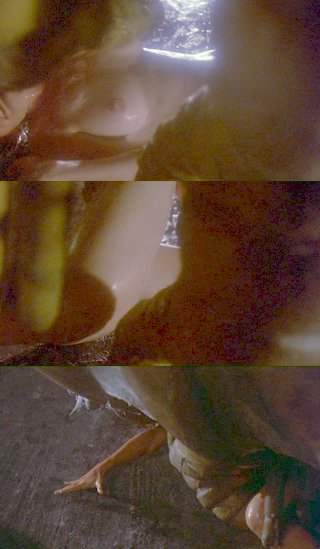Of Censorship and Giant Maggots
But when men have realized that time has upset many fighting faiths, they may come to believe even more than they believe the very foundations of their own conduct that the ultimate good desired is better reached by free trade in ideas — that the best test of truth is the power of the thought to get itself accepted in the competition of the market, and that truth is the only ground upon which their wishes safely can be carried out.
–Oliver Wendell Holmes, Jr., dissenting in Abrams v. United States, 250 U.S. 616 (1919).
My exploration of Roger Corman-related bonus material continued this week with the cast and crew interview features on the new release of Galaxy of Terror (1981).
Galaxy of Terror would probably be remembered today (if at all) as a minor, competently-made low-budget Alien rip-off but for one notorious scene. The set-up is something like this: A spaceship crew is dispatched to a strange, dark planet where a mysterious force generates monsters out of each crewmember’s deepest fears. Many grisly deaths result. Not a bad premise, so far. But one of these deaths turns out to be unusually kinky or unusually squicky or both. As Roger Corman himself explained in the interviews:
Of the various monsters which came out of each person’s unconscious, the one that was most famous and really became notorious at the time and helped to sell the film…was the monster coming out of Taaffe O’Connell’s unconscious.
Taaffe O’Connell played a character named Dameia, a highly competent spacefarer. And a stunner to boot. (She’s depicted to the left in her part as Dameia, and on the right in her present-day bonus-material interview.)

Dameia has just one little hang-up. As Corman puts it:
For the part of Taaffe I decided that in her unconscious mind she was afraid of sex. So for her we designed a monster maggot-like creature with certain phallic overtones.
Yes, indeed. The design for the maggot was apparently done by James Cameron, who got his start working for Corman and thus was able to join the likes of Francis Ford Coppola, Martin Scorsese, Jonathan Demme and a your-jaw-will-drop-when-you-see-the-list parade of others who got their start in that amazing one-man film school.

Now there’s an image to keep in mind the next time you see Titanic or Avatar.
And what does the giant icky maggot actually do to poor Dameia? Well, as Taaffe O’Connell puts it rather bluntly in her own cast interview:
…this woman succumbs to her greatest fear and her greatest pleasure.
And images from the sequence can make make matters blunter still.

In short, this sequence is a dramatization of a certain kind of pop-Freudian psychological conjecture: there are people whose conscious hate and fear of and disgust at something covers up unconscious desire for that very same thing.
Now is this conjecture a smart one? Perhaps. It does seem to me that there are certain psychological phenomena (homophobia is a clear example) for which it suggests at least a promising line of inquiry. But okay, maybe it’s a dumb idea. Maybe it’s even a pernicious idea (I hope I don’t have to spell out why that might be). But the more serious point here is that it is an idea, an interesting one, carried inside the unlikely vehicle of a B-grade horror movie. Good or bad? You might want to study the matter.
The film industry’s Moral Guardians, however, were not interested in having this matter available for you or anyone else to study. Galaxy of Terror editor R. J. Kizer explained:
Galaxy of Terror ran into several rating difficulties. First and foremost was the famous giant maggot scene. When we submitted the film we initially got an X rating. …[W]hat the rating board does is that won’t exactly tell you what is it that got you the rating. They just tell you, “well, you got an X rating.” The original concept of the maggot was the fact that the woman being attacked by the worm is in terror and then eventually comes to enjoy the experience. That was how she was directed, and that was how the thing was designed. So I had to take all of the erotic rhapsody looks out. I had to take out any suggestive movement of the maggot, there were — how else to put it? — humping movements being made by the worm and I had to take those out, so it looks like the maggot just kind of like… falls down on her and is just pressing down on her as if to crush her. So when I made all these little snips of film, and I went though and went through and resubmitted it we got an “R”. So Roger [Corman] comes into my room and says “I want to see what you took out.” And I had this box of trims, filled with little frames, a foot long to half a foot long to just a couple of frames to literally one frame of everything I had taken out all labeled where I took it out from…and I just reached randomly into the trim box and pulled this four-frame long piece of film. And I held it up. “Well, for example we started with this”…and Roger just looked at that four-frame piece of trim that I was holding in my hands and he says “Oh I don’t believe these MPAA people! I can’t! You take out four frames and we go from an X to an R. I give up. I don’t understand these people. Well, there’s no point even putting that stuff back in. Well, just ship it.” And he walked out.
So let’s reflect on what went on here. The MPAA has in effect just told us that it’s more or less okay to make a commercial movie in which a woman is stripped, raped, and killed by a giant slimy maggot and show said movie to youngsters, as long as they’re accompanied by a parent or guardian. Nice. But a slight variant the same scene, presented as the cinematic realization of an admittedly somewhat-disturbing erotic idea, will get your movie slapped with an X rating. Which means, of course, commercial death for the movie. The rating will keep the ideas in the movie out of the public realm just as effectively — if not more so — than if the gendarmes had trooped in and carried off the prints.
If someone wants to explain how behavior like the MPAA’s is consistent with the communicative norms of an open society, I am all ears.
And as for the little bits of trim in editor Kizer’s box? Lost for good, I’m sorry to say.
Similar Sex Blogging:
Shorter URL for sharing: https://www.erosblog.com/?p=5396








LOL @ “little bits of trim”. Way to turn a phrase…
If you’re interested in some more information about the MPAA and the rating system and this whole sort of craziness and absurd things they do I’d recommend the documentary This Film Is Not Yet Rated. They talk a lot about what exactly pushed a film from an R rating to NC-17 and showed a few scenes side by side of the NC-17 rated version with the R rated version and you can see what they had to take out to get it to an R.
Well, if giant maggots are your thing, then you’ll love Ken Russell’s (of “Tommy” fame…) “Lair of the White Worm”, co-written by Bram Stoker (Of Dracula fame…), starring the beautiful Catherine Oxenberg (Who played Princess Diana in “Charles and Diana: Unhappily Ever After”), the sexy Amanda Donohoe (as a dildo-wielding, venom-spitting, vampiric, snake priestess), eyelash-batting, award-winning Hugh Grant (arrested for lewd conduct in a public place with Hollywood prostitute Divine Brown, while dating model/actress Liz Hurley), and an actress named Sammi Davis, who later went on to play a character in a movie called “Soft Toilet Seats”, which I don’t believe was ever in any danger of being nominated for any Academy Awards…
Besides a gagged Oxenberg suspended by her wrists, the film has something kinky for everyone: fanged bloodsuckers, boy scouts and genital biting, and smutty puns and camp humor with a cult following second only perhaps to “The Rocky Horror Picture Show”.
Roger Corman’s book “How I Made A Hundred Films In Hollywood And Never Lost A Dime” is a great read. He would promise young filmmakers “Do this film for me and you’ll never have to work for me again”.